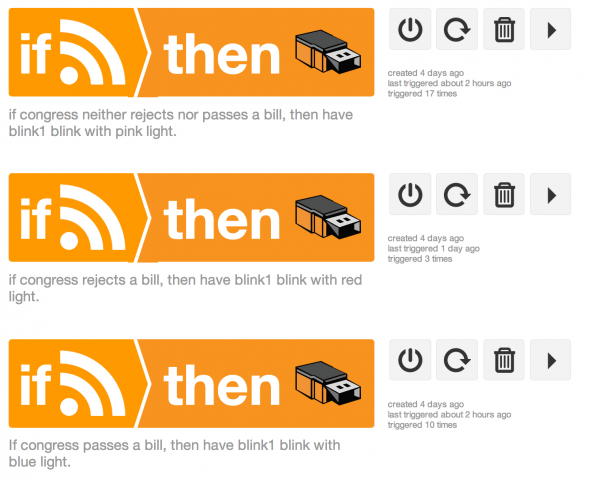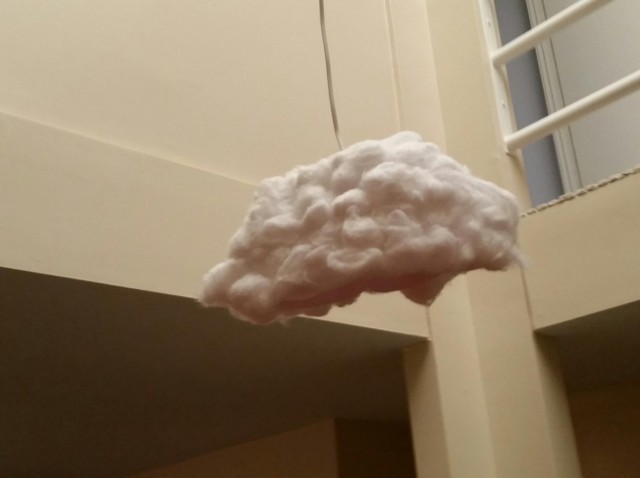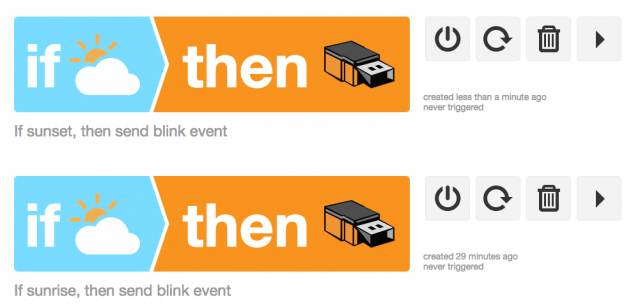BLINK
I happily did this project with Will Taylor link -./wht/09/10/assignment-03-blink/
I happily did this project with Will Taylor link -./wht/09/10/assignment-03-blink/
I collaborated with Charlotte.
See post here: ./cfs/09/08/blink1-transparency-charlie-charlotte/
Update on IFTTT recipes as of 7:50PM, Sep 10, 2014:

Looking for the Heart of a Virgin for your sacrificial needs?! No? Well how about just sex with one?! With this new contraption, I will be able to know when a virgin is ready to pop their cherry! This Blink1 light is connected to an IFTTT recipe that activates a pulsating red colored light into a heart sculpture every time a vigil posts on the Pittsburgh craigslist personal adds. An alternative presentation is having the light pulsate into a glittery vanilla-scented condom. Because lets be honest, your first time is ALWAYS magical <3 Peace and Love and Spread the joy of sex education.
-Kira and Alex

This design creates an indoor lighting system that changes color depending on outdoor sky color during sunsets and sunrises. For demonstration purposes we have a small cloud system with a Blink LED light inside that changes color when it recieves the correct IFTTT signal.
Here are our recipes:
 Once the trigger is… triggered, either the SUNSET or SUNRISE pattern is triggered for the lighting system, as seen here:
Once the trigger is… triggered, either the SUNSET or SUNRISE pattern is triggered for the lighting system, as seen here:
Demo modes are available, cycling through sunset/sunrise colors at 2seconds per color, but the live version takes approx. 3 minutes to complete (average sunset/sunrise time is 2-3min).
Project by Hizal Celik and Matthew Kellogg
For this project I collaborated with Liz to create a airplane mock up that you can find ./eaa/09/10/blink-project/
We couldn’t figure out the way to work it properly straight from the beginning so we took a way around so when the weather changed in either countries they would tweet to liz’s account and when it tweeted the blink(1) would light up.
For this assignment, David and I decided to program a Blink to play the entire movie Sunshine (2007) in full colour, pixel by pixel of every frame. The movie refers to a fictional story in which years into the future, the sun is dying and a crew of scientists travel towards the sun in order to reignite it through the use of an atomic bomb. We see our Blink as a mini-movie screen, not only to play a film, but also to emulate the constant source of the world’s warmth and light and the horrifying possibility of us losing such a source. In order to complete the entire film, the Blink would be changing colours for months and months.
Nathalie and I have use the blink as a surrogate sun. Specifically, our use of the blink(1) deals with the rotational deceleration of the earth relative to the sun. Earth’s days get longer by a few milliseconds every century, and this piece is a forced reminder of this. The light inside the sphere undergoes day-night cycles, each longer than the last. If left running long enough, the cycles would begin to take longer than our current 24 hour cycle. It serves the owner as a simple reminder, left somewhere to tell of huge forces normally forgotten.
this .gif is a loop of the first few cycles. while this presents the light as green, the top image is more representative of the lights true colour.
This is the code that controls the light:
Zach and I have developed a true “One-dimensional Marketer”. Our one dimensional marketing tool aims to decrease overhead costs, and increase workplace ambience by subconsciously streaming dynamically evolving colors, which correspond to advertisements of major corporations in Times Square, New York, into the minds of the workers in your workplace. Advertisers have attempted to work their way into the minds of our citizens at every point of the day , and our one dimensional marketing tool will bring them one step closer. And it is a step they will pay dearly to take. Decrease your overheads now with the “One-dimensional Marketer.”
So essentially, the Earth is getting slower.
Which is to say, the Earth’s rotation around the sun is very (very very very) gradually decelerating, and the length of a single day is increasing at about 1.7 seconds per century. What Guy and I hoped to show with our Blink(1) project is a sped-up representation of that, with the light representing the sun, blinking every time the Earth goes by. The reason it’s sped up is because obviously if we had its rate of blinking decreasing in real time, it would take a century to demonstrate, and we just don’t have that kind of time.
I suppose the purpose of it is to raise awareness, not in the sense that it’s something terrible that’s going to destroy our way of life, but as an interesting fact about the world we live on.
*if the gif decides not to work, click on it and it’ll open in a new tab and hopefully function.
For this assignment, Clair Chin and I decided to make a Space Weather Alert system to notify individuals when solar flares/other space weather events occur. We envisioned the blink(1) to be placed in a symbolic, sun-shaped lantern located in a household.
For our system to work, we created a twitter account (@SolarScanner) that would trigger the blink event. We created a list of solar weather twitters, then used the web service “RoundTeam” to automatically retweet any posts from this list. When a space weather alert is issued, or an M or X class solar flare is reported, the twitter we created (@SolarScanner) will trigger the blink device, and the lantern will illuminate.
A solar flare is a prime example of an unseen force that directly effects the earth. This space weather alert system creates a visual notification of these unseen forces. To expand on this project, I would create different colors/frequencies depending on the severity of the solar flare. It might also be interesting to expand the idea to other natural phenomena, such as earthquakes or meteorites.